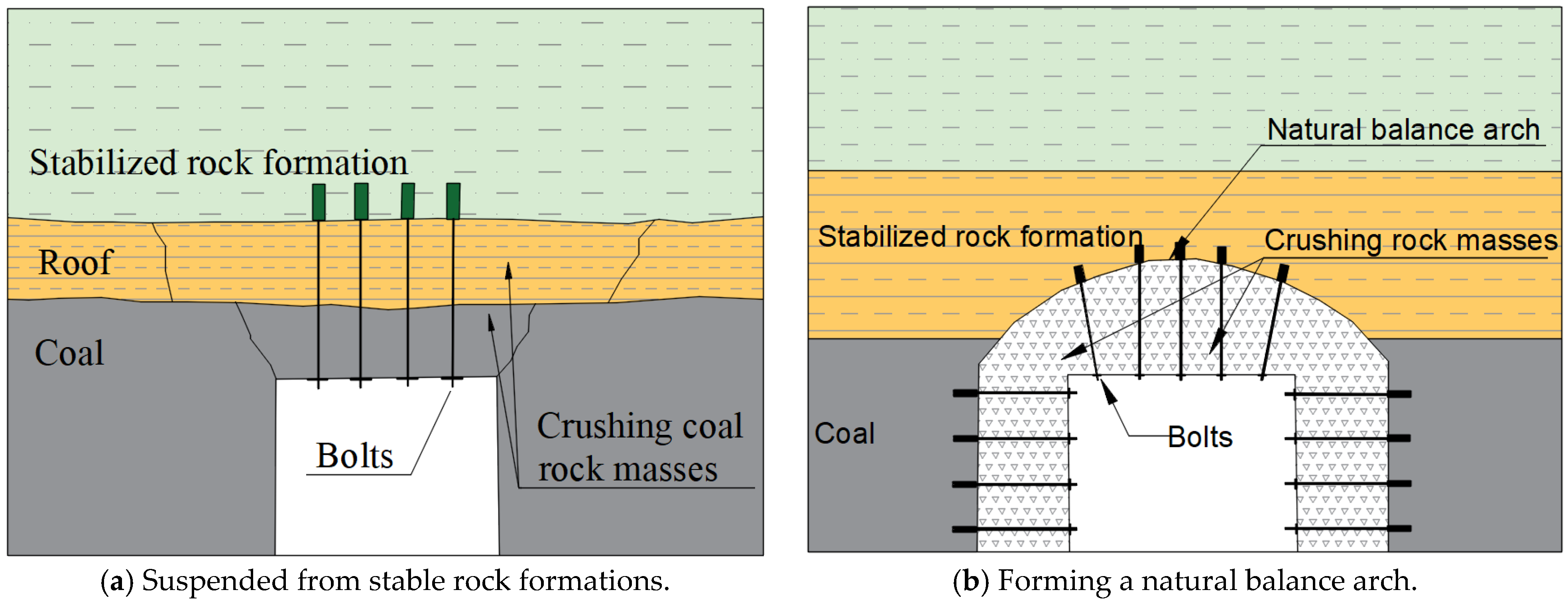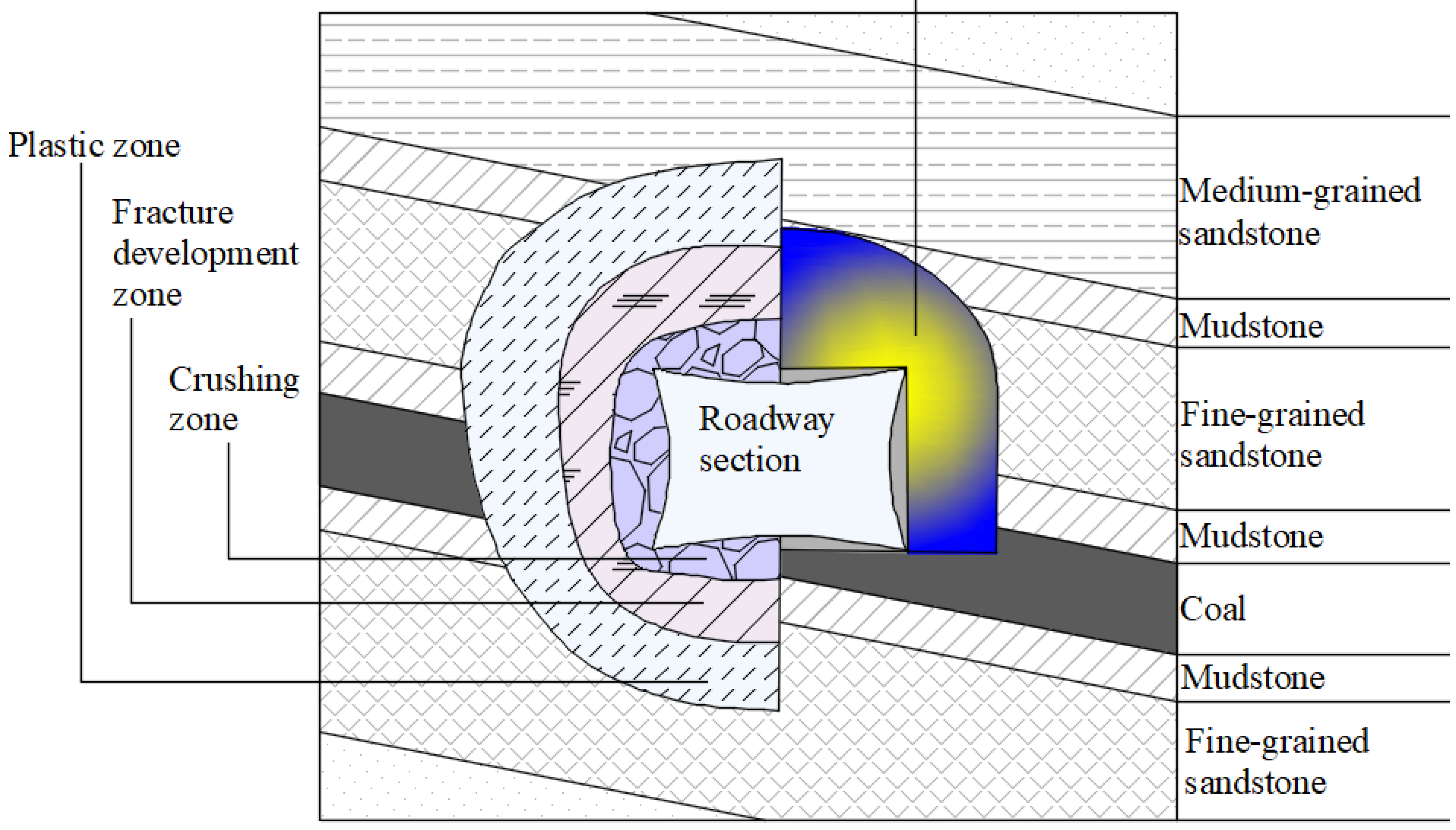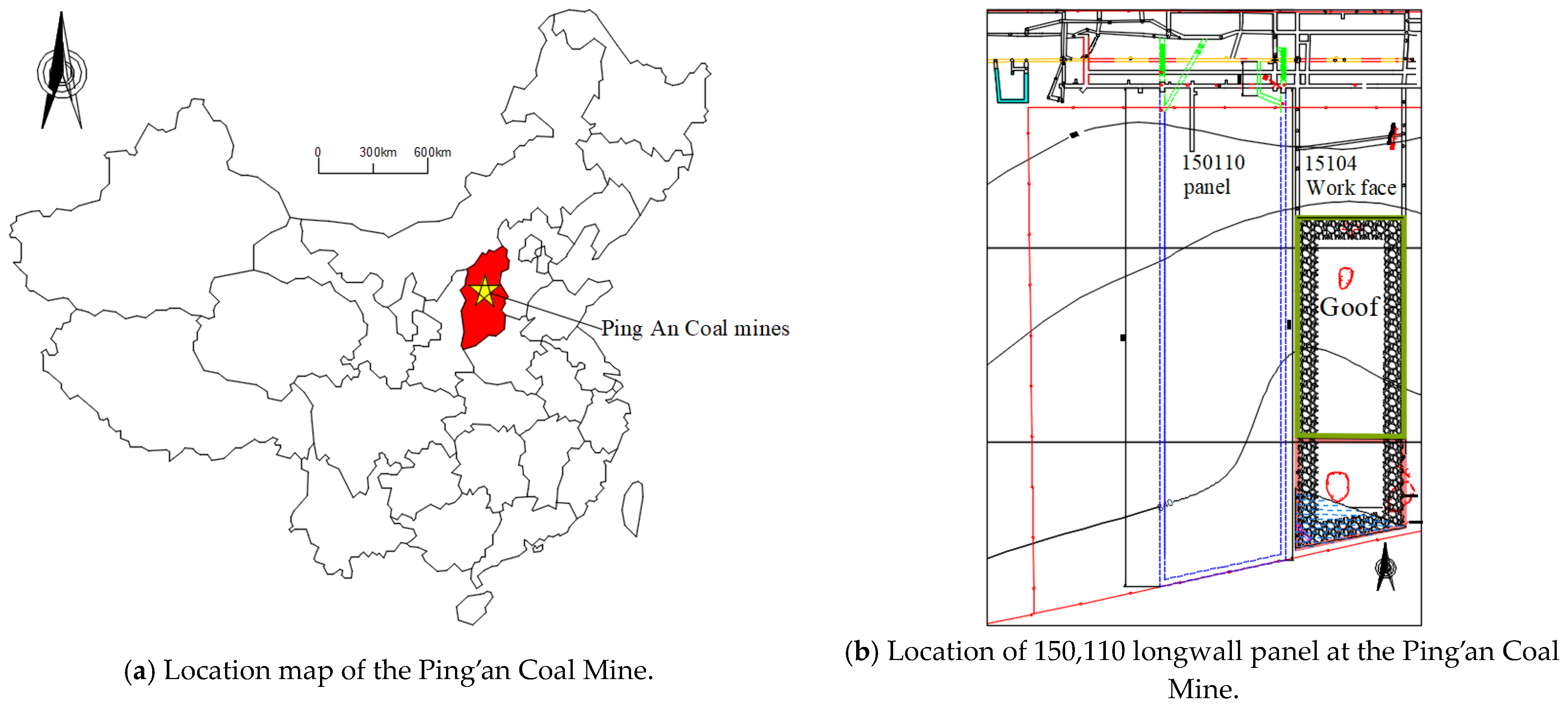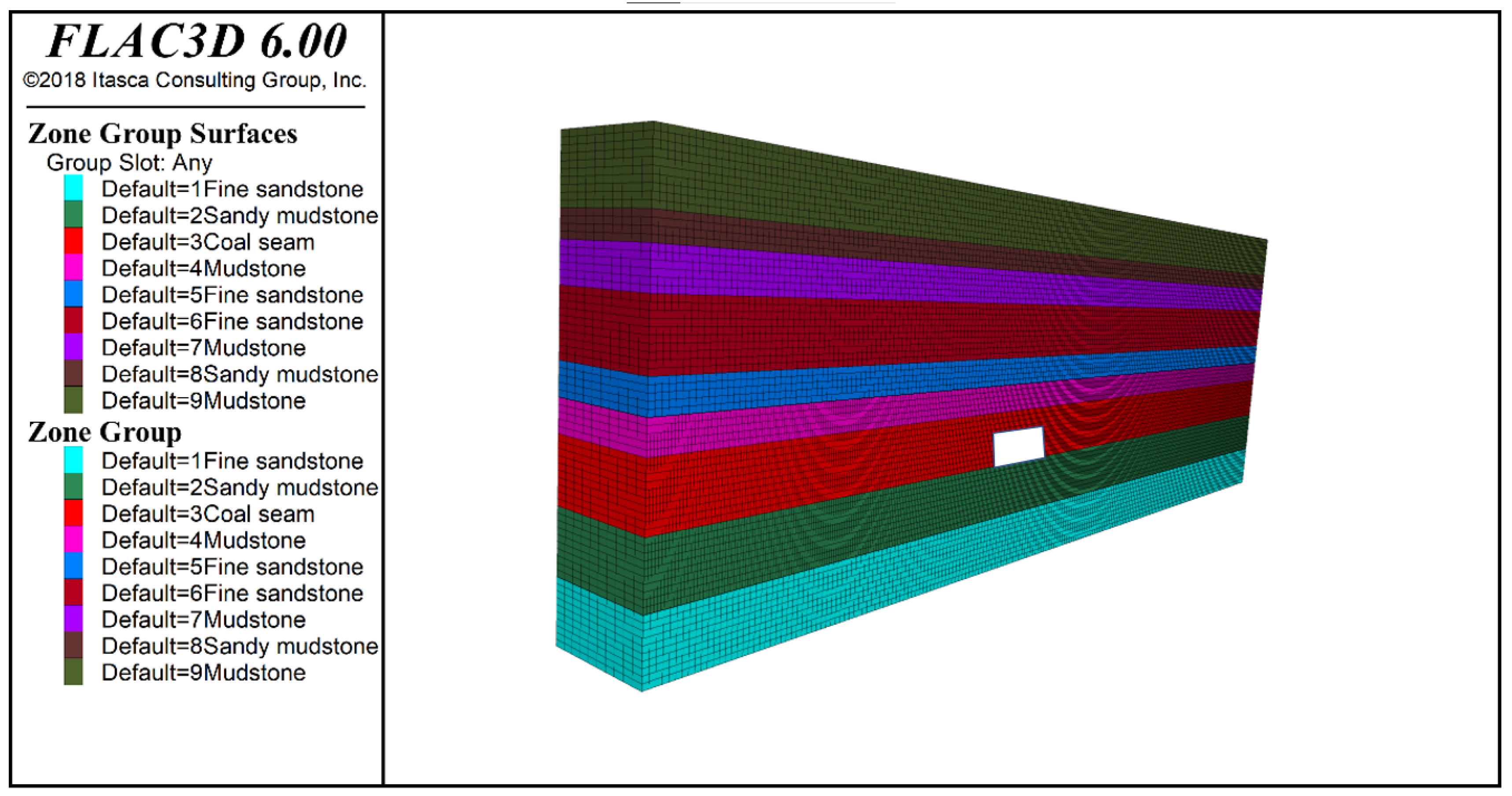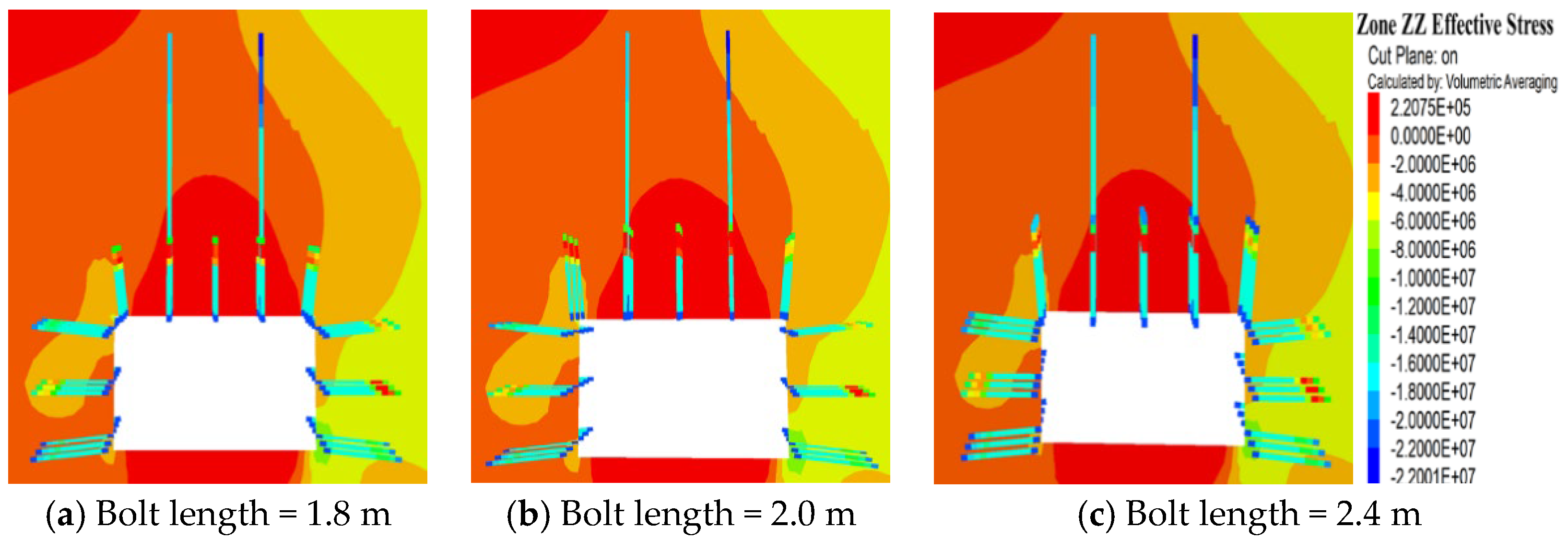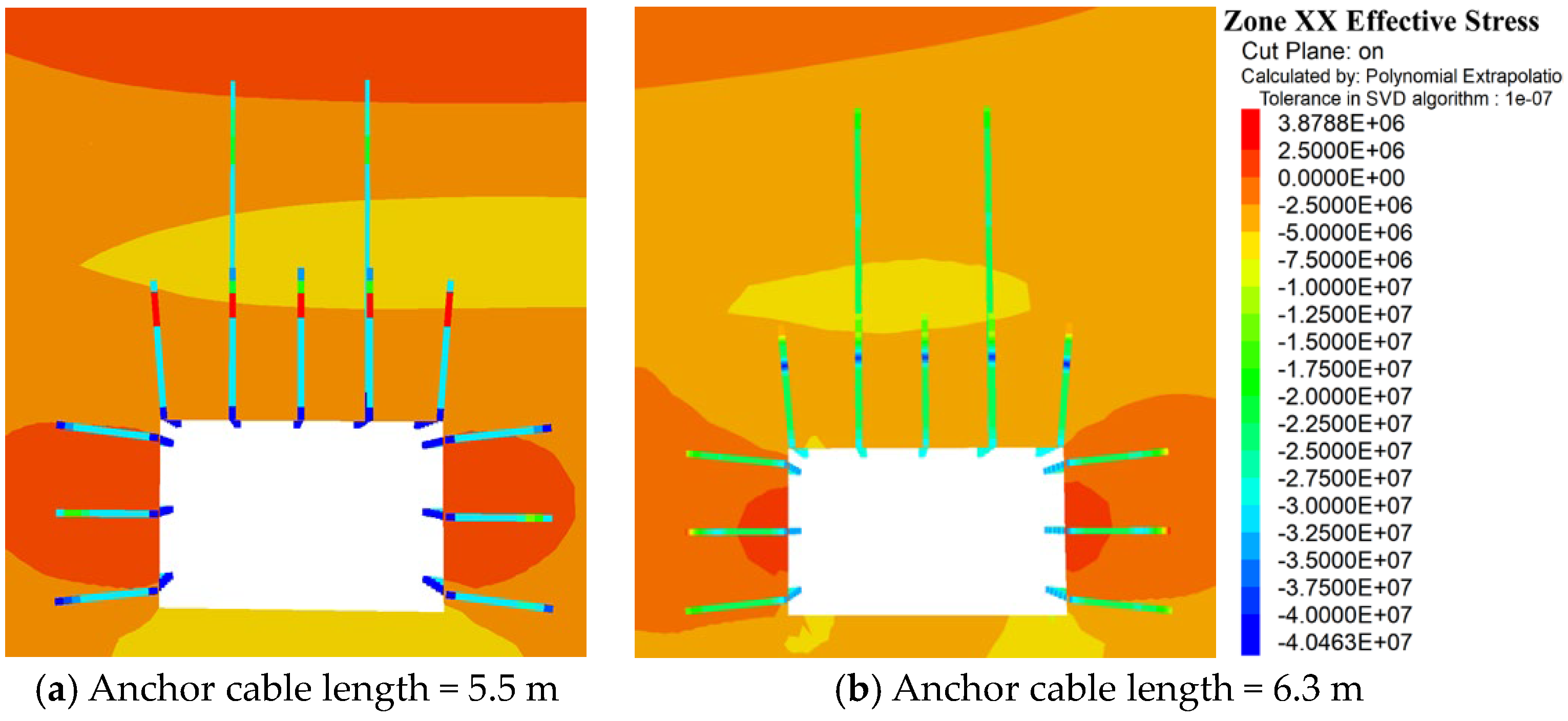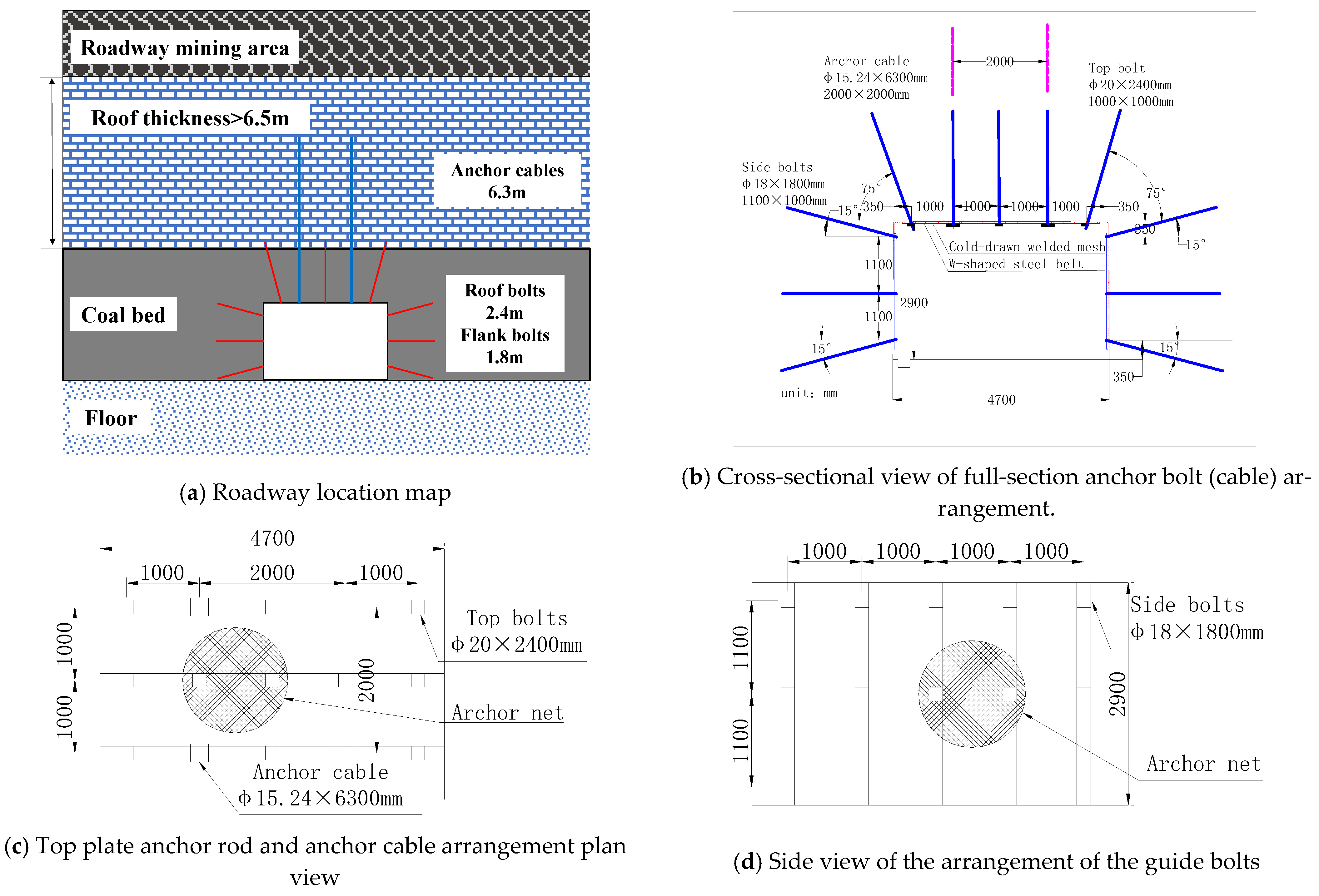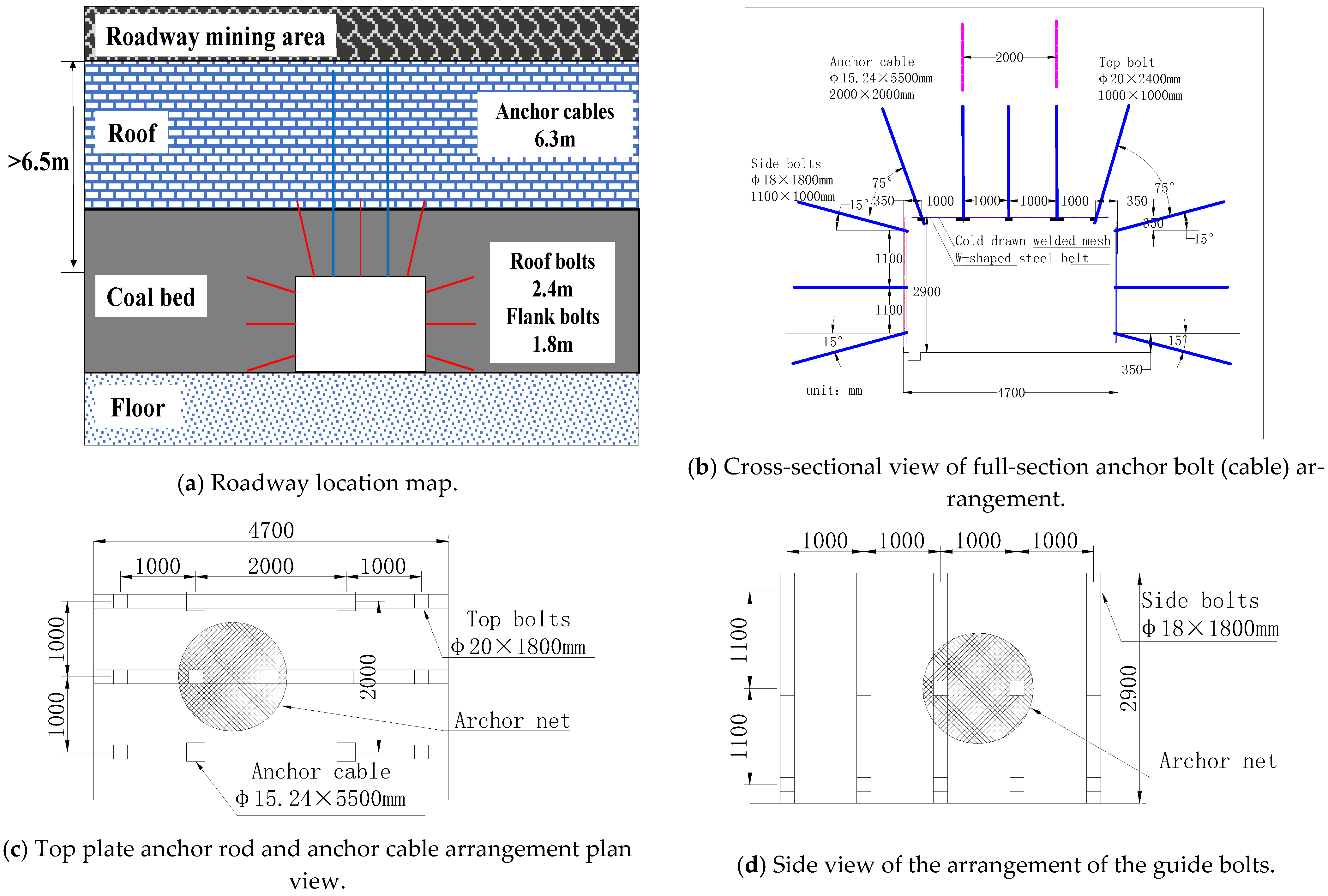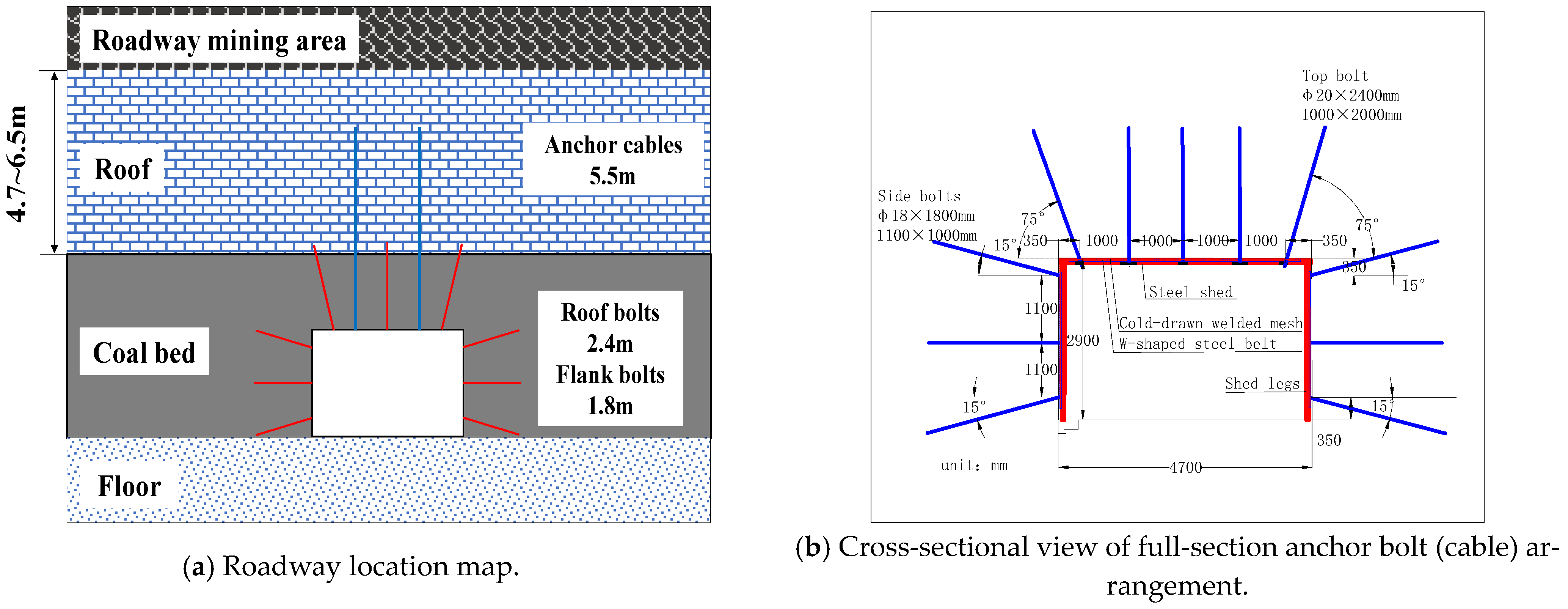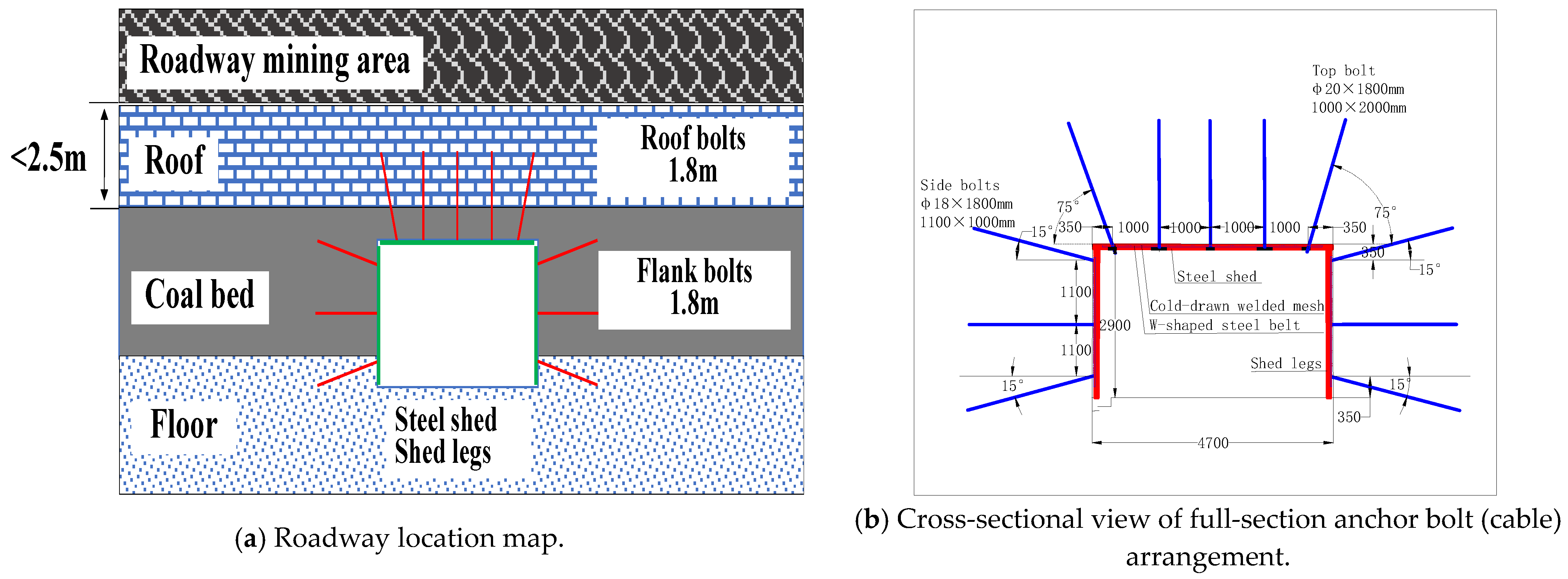4.1. Numerical Analysis of Spacing between Anchors Bolts
As the roadway advances, the spacing between the coal seam roof and the overlying roadway mining area becomes smaller and smaller. The maximum spacing between layers is more than 10 m, and the minimum is less than 2.4 m. The roadway is excavated along the floor, and the thickness of the supported coal seam roof is about 2.1 m. When considering the roof support, anchor bolts with a length of 1.8 m or 2.4 m and anchor cable with a length of 4.2 m or 6.3 m are used. Therefore, in the later design stage, in order to support the roof with anchor bolts and cables, and meet the requirements of anchoring the anchor bolts and cables to the stable rock layer, the distance between layers is divided into four categories for research and analysis, such as being greater than 6.5 m, 4.7 m to 6.5 m, 2.5 to 4.7 m, and less than 2.5 m.
Based on the actual geological conditions of Ping’an Coal Mine, and the changes between the coal seam roof and the overlying mining area during the excavation of the roadway, the support spacing was simulated in two cases: when the layer spacing between the coal seam roof and the overlying mining area was 10 m (using a combination of anchor net and anchor cable with 2.4 m long anchor bolts), and 2.5 m (not using anchor cable and using 1.8 m short anchor bolts). The simulated anchor spacing was 0.8 m, 1 m, and 1.2 m. By analyzing the displacement changes of the roadway’s roof, floor, and two sides, we determined the appropriate anchor support spacing.
The amount of subsidence of the roadway’s roof, floor heave, movement of solid coal pillars, and movement of coal column support was chosen as the analysis objects for the five different spacing scenarios. The relationship between the deformation of the roadway’s surrounding rock and the anchor spacing was analyzed, and the deformation pattern is shown in
Figure 8.
According to the figure, when the layer spacing between the no. 15 coal seam roof and the overlying roadway mining area is 10 m, with the increase in the anchor spacing, the deformation of the surrounding rock of the roadway gradually decreases, with the bottom heave being larger, and the deformation of the top and both sides being similar. When the layer spacing is 2.5 m, with the increase in the anchor spacing, the deformation of the surrounding rock of the roadway gradually decreases, showing an overall downward trend. From the perspective of the best support effect for the roadway, when using an anchor net and cable combined support with an anchor bolt length of 2.4 m, a 1000 mm spacing can achieve a more ideal control effect; when not using anchor cables and using short anchor rods of 1.8 m, a 1100 mm spacing can achieve a more ideal control effect. Therefore, when using an anchor net and cable combined support with an anchor bolt length of 2.4 m, the anchor spacing is determined to be 1000 mm; when not using anchor cables and using short anchor bolts of 1.8 m, the anchor spacing is determined to be 1100 mm.
4.2. Numerical Analysis of Anchor Bolt Length
The shorter the anchoring section of the anchor length, the larger the compression area of the anchoring body, and the larger the range of the anchoring body. The greater the preload, the larger the range of the anchoring body. However, the length of the anchoring section has a more obvious effect on the non-anchoring section rock under the surrounding conditions of the roadway surrounding rock. The longer the anchoring section, the smaller the corresponding compression area of the non-anchoring section rock. Therefore, end-anchoring can expand the range of the anchoring body more than full-length anchoring (without preload). However, the adhesive anchoring force of the end anchoring is relatively small and prone to debonding and instability. To solve this problem, segmented anchoring can be used; that is, the inner anchoring section is a fast coil end anchor, and the outer anchoring section is a slow coil full-length anchor. A given preload is applied before the outer section is not solidified, which not only achieves full-length (extended) anchoring, but also applies the preload to the full length of the anchor bolt, solving the contradiction of small compression area and small adhesive anchoring force, expands the range and stability of the anchoring body.
According to the number of anchor bolts used in the past roadway support of Ping’an Coal Mine, the types of anchor agents used in anchor bolt support are MSCK2360 resin cartridge and MSK2360 resin cartridge. One MSCK2360 resin cartridge and one MSK2360 resin cartridge are used for each anchor bolt, and the anchoring effect is good.
Based on the actual geological conditions of the 150,110 longwall panel with the 15,104 working face of Ping’an Coal Mine, during the excavation of the roadway, the distance between the coal seam roof and the upper roadway mining area will gradually decrease, and the maximum interlayer spacing exceeds 10 m, and the minimum is less than 2.5 m, or even smaller. Therefore, when supporting the roof, it is necessary to change the length of the anchor bolt according to the interlayer spacing. When the interlayer spacing is less than 2.5 m, anchor cables cannot be used to support the roof. In order to strengthen the roof support strength, steel shed support also needs to be added. Therefore, numerical simulation is used to study the use of anchor bolts with different lengths for roof support. Based on the existing roadway support parameters, five anchor bolts are arranged in one row for the roof, with a spacing of 1000 mm × 1000 mm, and the roof anchor cable is arranged in a 2-0-2 pattern with a spacing of 2000 mm × 2000 mm. For the rib, three anchor bolts are arranged in one row, with a spacing of 1100 mm × 1000 mm. In this simulation, anchor bolts with lengths of 2.4 m, 2.0 m, and 1.8 m are set according to the actual situation in the mine.
According to the ventilation air return roadway excavation situation of the 150,110 panel, the distance between the coal seam roof and the upper roadway excavation area is about 10 m to 15 m. The layer spacing will gradually decrease in the later stage. To determine the length of the anchor bolt for the roof support reasonably, the length of the anchor rope is considered to be 6300 mm. The roadway in the simulation is excavated along the coal seam floor, and the thickness of the supported coal is about 2.1 m. The layer spacing is set to be greater than 5 m, and the anchor rod lengths are set to be 2.4 m, 2.0 m, and 1.8 m, respectively. The simulation results are shown below.
(1) Characteristics of horizontal stress distribution in the X-axis direction of the surrounding rock of the roadway.
The horizontal stress distribution in the
X-axis direction of the surrounding rock of the three schemes is shown in
Figure 9.
(2) Vertical stress distribution characteristics in the Z-axis direction of the surrounding rock.
The vertical stress distribution in the
Z-axis direction of the surrounding rock of the three scheme roadways is shown in
Figure 10.
(3) Displacement characteristics of the surrounding rock
The displacement characteristics of the surrounding rock of the three scheme roadways are shown in
Figure 11.
Increasing the length of the anchor bolt can effectively increase the anchoring area of the surrounding rock in the roadway, forming a thicker superimposed stress area, thereby improving the mechanical parameters of the rock in the anchoring area of the roadway and better exerting the self-supporting capacity of the surrounding rock. From the simulation results, increasing the anchor bolt length from 1.8 m to 2.4 m reduces the maximum deformation of the roadway from 450 mm to 240 mm, the maximum horizontal stress in the X-axis direction decreases from −24 MPa to −20 MPa, and the maximum vertical stress in the Z-axis direction decreases from −22 MPa to −17 MPa. The plastic zone range of the surrounding rock roof is also significantly reduced, and the influence of anchor bolt length on the plastic zone range of both sides and the bottom plate is relatively small. Therefore, during the excavation process of the roadway in the west wing of the working face of the no. 15 coal seam, when the distance between the coal seam roof and the roadway excavation area is large and the use of 2.4 m long anchor bolts is feasible, it is proposed to consider using 2.4 m long anchor bolts first to achieve the best supporting effect, which is conducive to controlling the deformation of the surrounding rock in the roadway and reducing the degree of stress concentration.
As the excavation of the roadway in the 150,110 working face continues, the distance between the roadway excavation area and the coal seam roof may become increasingly closer, with the shortest distance possibly less than 2.5 m. When the distance between the coal seam roof and the roadway excavation area is small, the roadway roof may be more prone to fragmentation. Due to the prolonged existence of the overlying roadway excavation area, there may be many cracks in the roadway roof. To determine the appropriate length of the anchor bolt, the distance between the coal seam roof and the roadway excavation area is set to 2.5 m, with the roadway excavation area being 0.5 m above the coal seam floor and the thickness of the supporting coal seam being 2.5 m. The anchor bolt lengths are set to 2.4 m, 2.0 m and 1.8 m, and the simulation results are shown below.
- (1)
Characteristics of the horizontal stress distribution in the X-axis direction of the surrounding rock.
The horizontal stress distribution in the
X-axis direction of the surrounding rock in the three schemes is shown in
Figure 12.
- (2)
Vertical stress distribution characteristics in the Z-axis direction of the surrounding rock.
The vertical stress distribution in the
Z-axis direction of the surrounding rock of the three schemes, the roadway, is shown in
Figure 13.
- (3)
Displacement characteristics of the surrounding rock.
The displacement characteristics of the surrounding rock of the three scheme roadways are shown in
Figure 14.
When the distance between the roof of the coal seam and the overlying roadway excavation layer is less than 2.5 m, due to the small gap between the layers, the roof of the coal seam is prone to cracking and fragmentation. During the process of increasing the length of the anchor from 1.8 m to 2.4 m, the maximum displacement of the roof coal seam and the rib is about 15 to 20 cm. Since the roadway is located above the roadway excavation area, the surrounding rock stress is partially released, with a maximum horizontal stress of about 2.5 MPa and a maximum vertical stress of about 0.5 MPa. Because the layer spacing is 2.5 m, using anchor bolts that are 2.0 m or 2.4 m long can easily cause the roadway to connect with the roadway excavation area, leading to water accumulation or harmful gas influx into the roadway. Therefore, when the layer spacing between the top coal seam and the roadway excavation area is 2.5 m, it is proposed to use 1.8 m long anchor bolts to support the roof coal seam and reinforce the support with steel sheds to enhance the strength of the roof coal seam support and prevent coal from falling.
In summary, both the reasonable length and spacing of the anchor bolts are equally important. In this simulation, there are two different layer spacings, such as 10 m and 2.5 m, chosen for simulation based on the different layer spacings between the coal seam roof and the overlying roadway excavation layer. The change in rock stress during the support of the roadway was examined when the length of the roof coal seam anchor bolt altered from 1.8 m to 2.0 m and 2.4 m. It was found that when the layer spacing was 10 m, using a 2.4 m long anchor bolt with an anchor cable for roof coal seam support could efficiently control the coal seam roof, and the deformation degree of the roadway surrounding rock was relatively small. When the layer spacing was 2.5 m, using a 1.8 m long anchor bolt with a steel shed for coal seam roof support could efficiently control the coal seam roof. According to the engineering analogies, when the layer spacing is less than 2.5 m, using a 1.8 m long anchor bolt with a steel shed support can effectively control the roadway coal seam roof. When the layer spacing is between 2.5 m and 4.7 m, using a 2.4 m long anchor rod with a frame shed support can effectively control the roadway coal seam roof. When the layer spacing is greater than 4.7 m, a combination of anchor bolts and anchor cables can be used, and using a 2.4 m long anchor bolt with an anchor cable support can effectively control the roadway roof of the coal seam.
4.3. Numerical Analysis of Anchor Cable Length
Anchor cables have the characteristics of high anchoring depth, high bearing capacity, and the ability to apply large prestress, which can achieve a relatively ideal support effect. The prestress field of the anchor cable support is the stress field generated by the prestress of the anchor cable in the surrounding rock. It is mainly manifested in that with the increase in the anchor cable length, the range of the effective compressive stress zone gradually increases the height direction, but the change in the width direction is not obvious, and there is a trend of decrease with the increase in the anchor cable length. With the increase in the anchor cable length, the compressive stress of the upper part of the anchor cable and the surrounding rock between the anchor cables gradually decreases. When the prestress is constant, the active support effect of short anchor cables is better than that of long anchor cables, and the greater the length of the anchor cable, the greater the prestress applied. According to the current level of prestress, it is not suitable for the anchor cable to be too long, and it is more reasonable to choose a length of 4 m to 6 m.
Combined with the roof conditions of the roadway in the west wing of the no. 15 coal mining area of Ping’an Coal Mine, the control effect of anchor cables with a length of 5.5 m and 6.3 m on the roof is determined. The stress distribution and displacement of the surrounding rock in the roadway are analyzed and studied by numerical simulation. In the simulation, the length of the roof anchor bolt is 2.4 m, arranged in a row of five, with a spacing of 1000 × 1000 mm between rows, and the length of the side anchor bolt is 1.8 m, arranged in a row of three, with a spacing of 1100 × 1000 mm between rows. The spacing between anchor cables is 2000 × 2000 mm, and the 2-0-2 arrangement is adopted. When the distance between the coal seam roof and the roadway excavation face is 10 m, a 6.3 m anchor cable is used for support in the simulation, and when the distance is between 4.7 m to 6.5 m, a 5.5 m anchor cable is used for support. The simulation results are shown below.
- (1)
Characteristics of the horizontal stress distribution of the surrounding rock in the X-axis direction.
The horizontal stress distribution of the surrounding rock in the
X-axis direction of the three schemes is shown in
Figure 15.
- (2)
Vertical stress distribution characteristics in the Z-axis direction of the surrounding rock.
The vertical stress distribution in the
Z-axis direction of the surrounding rock of the three scheme roadways is shown in
Figure 16.
According to
Figure 15 and
Figure 16, when the distance between the coal seam roof and the roadway excavation face satisfies the use of anchor cables, the use of anchor bolts and anchor cables to support the roof can enhance its stability. Suspension stabilization of the pressure arch formed by the anchor bolt is achieved by using anchor cables with lengths of 5.5 m and 6.3 m. Since the overlying strata are roadway excavation faces, the horizontal stress in the roadway roof is partially released and is approximately 2.5 MPa to 4.0 MPa, while the vertical stress is about 1.0 MPa to 2.0 MPa. In the simulation results, the vertical displacement of the roof is small, about 10 cm, and the deformation of the roadway roof is also small. When the distance between the coal seam roof and the roadway excavation face is greater than 6.5 m, using a 6.3 m anchor cable can effectively support the roof, while when the distance is between 4.7 m to 6.5 m, using a 5.5 m anchor cable can effectively stabilize the roof.
Therefore, when supporting the roadway excavation face of working face 150,110, if the distance between the layers satisfies the conditions for using anchor cables, using anchor bolts and anchor cables with lengths of 5.5 m or 6.3 m to support the roof can effectively control its deformation.
4.4. Proposed Roadway Roof Control and Support Schemes
The roadway design in this study includes four roadways for the belt and ventilation in the 150,110 working face. Based on the mining conditions of the adjacent 15,104 working face and the excavation status of the belt roadway in the 150,110 working face, it is known that there is a roadway excavation face in the overlying strata, and the roof of the no. 15 coal seam is prone to breakage under mining influence. As the roadway advances, the distance between the roadway and the excavation face becomes closer, with a maximum distance of 10 m to 15 m and a minimum distance of less than 2.5 m. To safely and scientifically support the roadway, considering the layer spacing between the coal seam roof and the excavation face and the characteristics of the roof strata, and considering that the length of the anchor bolt is 1.8 m or 2.4 m and the length of the anchor cable is 5.5 m or 6.3 m, four roof control and support schemes are proposed, as shown in
Table 2.
This design is based on analogizing the adjacent 15,104 working face support situation and combined with the actual situation of the 150,110 working face to determine the design parameters. In the design, the cross-section of the roadway is rectangular with a gross width of 4.7 m, gross height of 2.9 m, and gross section of 13.63 m2. The net width is 4.5 m, the net height is 2.8 m, and the net section is 12.6 m2. The roadway is excavated along the coal seam floor with an average thickness of 5.02 m, and the gross height of the roadway is 2.9 m, resulting in the presence of supporting coal. The interlayer distance refers to the distance between the no. 1 and no. 15 coal seam roof and the overlying roadway excavation area.
4.4.1. Support Scheme for Layer Spacing Greater Than 6.5 m
When the distance between the coal seam and the overlying “mining area” is above 6.5 m, the roadway is excavated along the floor, and the thickness of the supported coal is about 2.1 m. An anchor net and cable are used for support, and a 6.3 m long steel strand is selected for the anchor cable to ensure that the anchor point is fixed in a stable rock layer. The material and specifications of anchors, nets, and cables can use existing support materials, and the support parameters follow the current anchor net support parameters, as shown in
Figure 17.
4.4.2. Support Scheme for Layer Spacing of 4.7 m to 6.5 m
When the spacing between the coal seam and the overlying “roadway mining area” is 4.7 m to 6.5 m, the roadway is excavated along the floor and the roof coal thickness is about 2.1 m. An anchor net and cable are used for support, and 5.5 m long steel strand cables are used for anchoring. It is ensured that the anchoring end of the cable is anchored in the stable rock layer. The materials and specifications of anchors, nets, and cables can use existing support materials, and the support parameters are executed according to the current anchor net support parameters, as shown in
Figure 18.
4.4.3. Support Scheme for Layer Spacing of 2.5 m to 4.7 m
When the distance between the coal seam and the overlying roadway excavation layer is between 2.5 to 4.7 m, the roadway should be excavated along the coal floor with a thickness of about 2.1 m, and the support method used should be a combination of anchor bolts and steel shed support. When supporting the roof, anchor cables should not be used. Instead, a steel shed support made of 2.4 m long anchor bolts, anchor nets, and no. 14 industrial and mining steel should be used. The anchor bolts should be spaced at 1000 mm × 2000 mm and arranged in a staggered pattern with the steel sheds. The support in the middle section should be the same as the existing support method. The materials and specifications of the anchors, nets, and cables should be the same as the existing support materials, as shown in
Figure 19.
4.4.4. Support Scheme for Layer Spacing Less Than 2.5 m
When the distance between the coal seam and the overlying roadway is less than 2.5 m, to ensure the thickness of the anchoring support for the roadway roof, the construction plan of retaining the roof coal and breaking the floor must be adopted. It is necessary to ensure that the distance between the roadway roof and the roadway mining area is not less than 2.5 m, so that the roof has a certain thickness to play a bearing role. At this time, the support method is anchor bolt + anchor net + steel shed support. The length of the roof anchor bolt is 1.8 m, and the steel shed and shed legs are made of no. 14 industrial and mining steel. The spacing between the roof anchor rods is 1000 mm × 2000 mm, and they are arranged staggered with the steel shed. The material and specifications of the anchor, net, and cable for the help support are the same as the existing support materials, as shown in
Figure 20.
This part puts forward a specific implementation plan for the section support of the 150110 roadway of Ping’an Coal Mine. The roof thickness is divided into four support schemes according to more than 6.5 m, 6.5 to 4.7 m, 4.7 to 2.5 m and less than 2.5 m. Under the premise of controlling costs, the safety of roadway construction and the stability of surrounding rock control of Ping’an Coal Mine 150,110 are greatly improved, and it is worth engineering analogy with roadway with similar conditions. However, new problems were also discovered during construction:
1. The weakening effect of the water on the roof plate is further revealed, and it may be necessary to optimize the support scheme of some sections.
2. The new borehole revealed a new seam 6.0 m above the trough with a thickness of about one meter, and we recommend a length of 8.0 when the seam thickness is less than 1.0 m, diameter φ 15.24 mm anchor cable for support. When the coal seam exceeds 1 at 0 m, it is recommended to use an anchor cable with a length of 10.0 m and a diameter of φ17.8 mm for support. In order to avoid the anchoring section of the anchor cable in the coal seam, the supporting effect is weakened.
Roadway rock control is a dynamic scheme design that requires continuous optimization. While we are supporting, the geological conditions are in a dynamic change process, so a timely and flexible selection and optimization of support solutions is an important guarantee for safe production.
